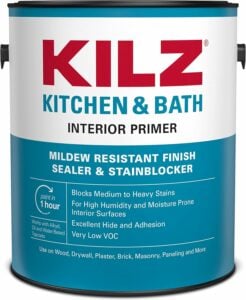Randy Charles is the owner of PaintCentric.com, a website dedicated to providing information, tips, tricks, and news about all things paint. With over 10 years...Read more
High humidity in bathrooms means there’s a lot of water in the air. This happens mostly after you take a hot shower or bath. The steam from the hot water makes the air wet. This wet air can make walls damp. It can also lead to mold and peeling paint. It’s important to use special paint for these wet conditions.
Can You Paint in High Humidity?
Yes, you can paint in high humidity, but it’s tricky. The paint might take longer to dry. It might not stick well if it’s too wet. Use a dehumidifier or fan to make the air less wet. Paint when it’s less humid, like on a sunny day. This helps the paint dry better and stick well.
Paint Suitable for High Humidity
In high-humidity areas like bathrooms, the right paint can make a significant difference. Humidity, the presence of moisture in the air, can cause various problems for wall surfaces, including peeling paint, mold, and mildew growth. To combat these issues, paints designed specifically for high humidity conditions are essential.
1. Moisture Resistance This is a crucial feature. Paints that resist moisture prevent water from seeping into the walls, thus reducing the risk of damage caused by humidity.
2. Mold and Mildew Resistance High-humidity environments are breeding grounds for mold and mildew. Paints with built-in mold and mildew resistance help maintain a healthy and clean bathroom environment.
3. Durability Such paints are formulated to withstand frequent cleaning and exposure to moisture, ensuring they last longer despite the challenging conditions.
4. Ease of Cleaning Bathrooms need regular cleaning, and these paints allow for easy wiping and scrubbing without damaging the paint surface.
5. Quality of Finish Despite the practical requirements, the aesthetic aspect isn’t compromised. These paints come in various finishes like matte, satin, or semi-gloss, allowing for flexibility in design and style preferences.
How to Reduce Bathroom Humidity?
To cut down on wet air in your bathroom, use a fan. It helps pull the steam out. Opening a window also lets fresh air in and steam out. Keep your bathroom clean and dry. Wipe down walls and fix any leaks. These steps help keep humidity low and stop mold and damage.
Top Paint for High Humidity Bathroom
Rust-Oleum Perma-White Mold and Mildew Resistant Paint

For a bathroom that faces the constant challenge of humidity, Rust-Oleum Perma-White stands as a reliable guard. This paint is not just about keeping your walls white; it’s engineered to resist the growth of mold and mildew, common enemies in any bathroom.
The secret lies in its composition, a blend of durable acrylic latex with fungicides. This combination ensures that your bathroom walls don’t just look clean but stay free from the unsightly and unhealthy growth of mold. It’s a perfect choice for maintaining a clean, hygienic bathroom environment.
BEHR PREMIUM PLUS Ultra Stain Blocking Interior Satin Enamel

This paint from BEHR is a champion in maintaining the aesthetic appeal of your bathroom. Its stain-blocking technology is a lifesaver, especially in a space prone to various splashes and spills. Whether it’s toothpaste, hair products, or watermarks, this paint ensures these everyday incidents don’t leave a lasting impact.
The satin enamel finish adds a touch of elegance, making your bathroom not just a functional space but also a visually appealing one. Its resilience and vibrant finish make it an ideal choice for a bathroom that combines utility with style.
Benjamin Moore Aura Bath and Spa Paint

When luxury meets functionality, you get Benjamin Moore’s Aura Bath and Spa Paint. This product is not just paint; it’s an experience. Designed specifically for high-humidity areas like bathrooms, it offers excellent moisture resistance. The satin finish is not just about looks; it’s also about creating a soothing ambiance, reminiscent of a spa.
This paint transforms your bathroom into an elegant and serene haven, where the worries of mold and moisture are distant thoughts. It’s an ideal choice for those who seek to combine luxury with practicality in their bathroom decor.
Sherwin-Williams Emerald Interior Satin Latex

The Sherwin-Williams offers the Emerald Interior Satin Latex. This paint is a testament to the possibility of combining eco-friendliness with high performance. With low VOCs, it’s a healthier choice for your home and the planet. But don’t let its gentle impact on the environment fool you; it’s tough on challenges posed by bathroom humidity. Offering great coverage and washability, this paint ensures your bathroom walls stay beautiful and durable, without compromising on environmental values.
KILZ Kitchen & Bath Ceiling Paint

Often overlooked, the ceiling is an integral part of your bathroom’s overall health and aesthetic. KILZ Kitchen & Bath Ceiling Paint is specifically formulated to tackle the unique challenges of bathroom ceilings. It addresses the issues of moisture and steam, preventing unsightly stains and peeling.
Its mildew-resistant formula is a boon for spaces that are not well-ventilated, ensuring that your ceiling remains as pristine as your walls. This paint is a comprehensive solution for those who understand the importance of covering every corner in their battle against bathroom humidity.
Conclusion
Choosing the right paint for a humid bathroom is key. It helps protect your walls and keeps them looking good. The best paints for humid bathrooms resist mold, moisture, and stains. They are also easy to clean. Reducing humidity in your bathroom is important too. It helps keep your paint and walls in good shape.
FAQ
What is the Best Type of Paint for a Bathroom with High Humidity?
For bathrooms with high humidity, the best type of paint is one that is specifically designed for wet environments. Look for paints labeled as moisture-resistant, mold and mildew-resistant, and suitable for high-humidity areas. These typically come in acrylic or latex varieties, offering durability and protection against the common problems of moisture and mold growth.
How Often Should I Repaint My Bathroom to Combat Humidity?
The frequency of repainting your bathroom depends on various factors, including the quality of the paint used, ventilation in the bathroom, and the level of humidity. Good quality bathroom paint in a well-ventilated space can last 3 to 5 years. If you notice peeling, discoloration, or mold growth, it might be time for a new coat.
Can Regular Interior Paint be Used in a High Humidity Bathroom?
While regular interior paint can be used in a bathroom, it’s not ideal for high-humidity areas. These paints may not have the necessary properties to withstand constant moisture, leading to quicker deterioration, mold growth, and peeling. It’s better to use paint specifically formulated for bathrooms or high-humidity environments.
Does the Color of the Paint Affect Its Performance in Humid Conditions?
The color of the paint does not affect its performance in terms of resistance to humidity, mold, or mildew. What matters is the type of paint and its specific properties. Lighter colors might show mold and mildew more easily than darker ones, requiring more frequent cleaning or repainting.

Randy Charles is the owner of PaintCentric.com, a website dedicated to providing information, tips, tricks, and news about all things paint. With over 10 years of experience in the painting industry, Randy has become an expert in the field and is passionate about helping others learn more about painting. He has written numerous articles on the subject and is committed to providing accurate and up-to-date information to his readers.
- Latest Posts by Randy Charles
-
How Much Do You Tip Painters? The Ultimate Guide
- -
Can You Paint Over Rust Converter?
- -
Can You Paint Inside When It Is Raining?
- All Posts
